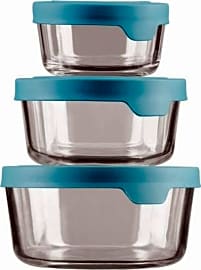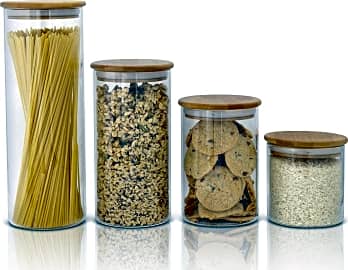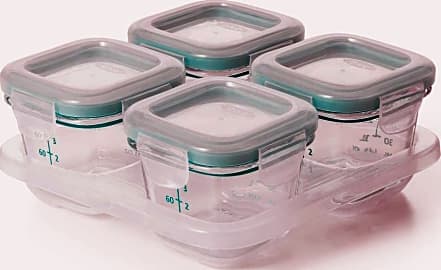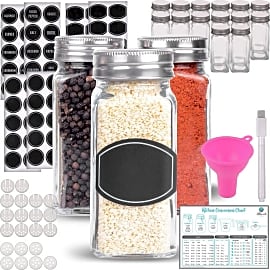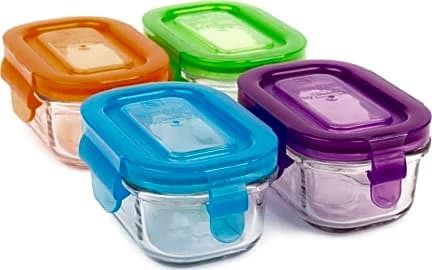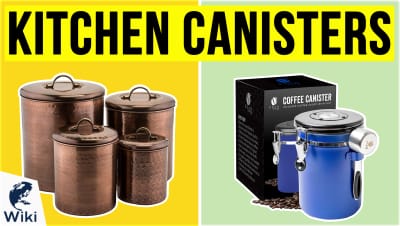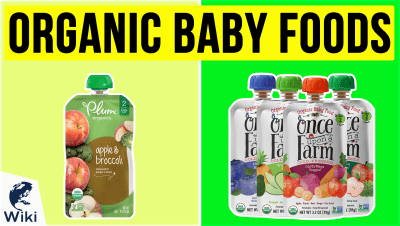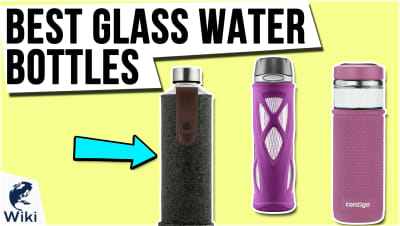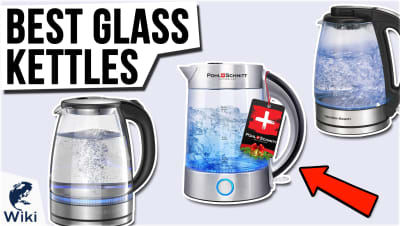The 10 Best Glass Storage Containers

This wiki has been updated 43 times since it was first published in April of 2015. Plastic food storage solutions are a popular choice for many busy households, but they can be difficult to clean, become discolored easily, and may warp or melt if they get too hot. These sturdy glass containers are a better alternative, as they’re resistant to odors and stains, are made without any harmful chemicals, and are often safe for the dishwasher, freezer, microwave, and oven. When users buy our independently chosen editorial recommendations, we may earn commissions to help fund the Wiki.
Editor's Notes
August 24, 2020:
In today’s update, we replaced the Pyrex Smart Essentials Mixing Bowls with the more versatile Pyrex Simply Store Set, and moved this item from the second spot into the number one location on our list. The nine round and rectangular containers stack neatly for compact storage, and they’re highly durable. The red, orange, blue, and green lids make it easy to match the shape to the corresponding base. Their tempered glass construction makes them less likely to break in the event they’re dropped, and their lids are relatively easy to close, which makes quick and painless work of transferring your leftovers to the containers. Regrettably, today we found it necessary to remove the Glasslock 18-Piece Assortment from our selection; although they’re advertised as microwave safe, there have been various reports that they shatter while being used to reheat foods in the microwave. In their place, we added the Sweetzer & Orange Kitchen Canisters, which bring to the list another option that’s good for non-refrigerated items like dry pasta, rice, baked cookies, and more. These thoughtfully designed kitchen canisters come with bamboo lids that make a satisfying swoosh noise as you’re sliding them onto the glass bases, and an equally satisfying pop when you remove them. This is because they’re hermetically sealed for optimum freshness. They come in an attractive gift box, which makes them a nice present for any foodie or new homeowner in your life.
In this update, we kept the Anchor Hocking TrueSeal high on the list, as it’s hard to beat when it comes to an airtight design that allows them to be nestled in a cabinet or stacked in the fridge. True to their name, they feature BPA-free, textured lids that seamlessly form to the bases. They can be written on safely using a dry-erase marker, and are safe for placement on the top rack of a dishwasher. If you’ve got young kids, you can’t go wrong with the Oxo Tot Baby Blocks, which is a set of four-ounce cubes that come with your choice of pink or teal lids, and they’re well suited for portioning and storing baby food or snacks for tots. They transition with ease from the freezer directly to the microwave or the oven, and the lids snap shut securely to keep foods fresh and liquids contained. For a slightly larger selection that’s great for storing kid-sized portions, check out the Wean Green Snack Cubes, which come with colorful lids that are easy for little fingers to attach and remove from the bases. If you want to save leftover meat or fish, plus multiple sides from your dinner, the MealPrep Divided is up for the task. It comes in a set of three, and each in turn contains three compartments, making it easy to enjoy last night's dinner for lunch at work.
May 03, 2019:
While large containers like the Pyrex Smart Essentials bowl set can come in handy for marinating meats and storing pre-mixed batters, space-saving options like Snapware and Glasslock that seal tightly, nest and stack easily can make it a lot easier to keep your pantry and fridge neatly arranged. You can also keep your assortment of dried herbs and spices organized by using spice jars with rewritable chalkboard labels, and OXO Tot Blocks can be used for anything from homemade baby food to individual portions of pesto.
Special Honors
Williams Sonoma Glass Canister Whether you’re storing coffee, tea, grains, or herbs, this airtight container will keep your ingredients fresh and protected. Jut press the twin-valve lid to the surface of the food inside to remove air and lock in freshness. Its see-through construction makes it easy to know what’s inside and when it needs to be refilled, and its lid is made of stainless steel and plastic, with a flexible silicone gasket. It’s available in several sizes, with capacities ranging from three ounces to nearly three quarts. williams-sonoma.com
A Brief History Of Glass
Blown plates of glass would be common by the early 1600s, and then in the 19th Century glassmaking technology lurched dramatically forward.
Mankind first began to make glass sometime in the third millennium before the Common Era. Archeological evidence points to craftsman in regions now falling within the borders of Syria, Egypt, and several other nearby countries. Early glass (and indeed many types of glass made throughout human history) was made in much the same way naturally forming volcanic glass is created: by the super heating and then rapid cooling of compounds with a high silica content, an example of which is basic sand.
Glass was initially formed into beads and small objects likely used for decorative and ornamental purposes and for trade. True mastery over the creation of and control over glassmaking and glass craftsmanship would not commence for more than a thousand years after its method of creation was devised. By the middle of the second millennium BCE, however, glass was becoming less and less of a rarity, and was more often used to create objects used not just for decoration or devotion, but for everyday life.
Glassmaking was common in Ancient Rome, with the modern word for glass even descending from the Latin word glesum. By the early centuries of the Common Era, artisans were making elaborate and ornate artifacts out of glass in many parts of the world. Delicate drinking glasses and finely crafter vases were being made across much of Asia, while in other parts of the world the usefulness of glass as a building material had been fully embraced.
Excavations of early Medieval buildings across much of Europe show extensive use of glass for windows, and by around the year 1000, the glass used in windows was not merely chosen for translucence, but also for aesthetics. Churches from the late Anglo-Saxon and early Norman years had windows outfitted with elegant stained glass.
By the 13th Century, craftsman were making simple sheets of glass suitable for use in small windows. Blown plates of glass would be common by the early 1600s, and then in the 19th Century glassmaking technology lurched dramatically forward. That century saw the advent of tempered glass, which resists shattering and heat distortion, rolled glass, which can feature patterns and texture, and an early forerunner of safety glass, too.
Today, the medium is used for everything from windows to fiber optic cables to furniture. And glass is having a moment of elevated popularity with health and wellness conscious consumers turning away from plastics for use in food storage containers. Inherently free of many of the potentially harmful chemicals found in plastics, including BPA (or Bisphenol A), glass is a great choice for food storage, transport, and even for cooking.
Choosing The Right Glass Storage Containers
First, a few words on why glass storage containers are superior to other food storage options. As mentioned above, glass imparts no harmful chemicals or compounds into your foods. Glass also neither imparts nor absorbs unpleasant odors, tastes, or colors, so your foods will have their flavor profile unblemished, and your glass containers will remain taste and scent neutral, provided you clean them well. And cleaning most glass storage containers is easy as almost all of them can be tossed in the dishwasher, and they stand up to rugged scrubbing when needed.
As mentioned above, glass imparts no harmful chemicals or compounds into your foods.
Unlike any plastic food storage containers, many glass options are also both freezer and oven safe, and most are microwave safe as well. That means easy reheating of leftovers or long term storage of frozen foods. Many glass containers also make excellent servicing dishes -- for everything from a dip or sauce to a main course, depending on their size -- which can simplify food service.
There are so many different sets of glass storage containers available, it can be hard to know where to start your consideration process. So instead of first looking at sets of glassware, first look at the leftover foods you and your family regularly end up with, and/or at the types of snacks, fruits, and vegetables you like to have on hand. It will be easier to envision (or write out) all the types of foods you would like to be able to store well and then to see which set (or sets) of glass storage containers will work best for you.
If you're mainly looking for leftover storage, then choose a set with a few larger containers. If you're selecting a set intended to help you prep and sort snacks or lunches, then a set with many sizes of containers and varied colors of tops is a fine idea.
Easy Make Ahead Meal Ideas
One of the greatest gifts you can give yourself is the gift of time. And one of the best ways to do that is to cook large batches of foods that can be frozen for later reheating and enjoyment with minimal work.
If you have a set of glass storage containers that are both freezer, microwave, and oven safe, then you are already well on your way to easy, delicious, nutritious meals that require minimal prep time when it's time to eat.
One of the greatest gifts you can give yourself is the gift of time.
While perhaps the easiest "freezer meals" are large batches of soups or stews portioned out into individual sizes of glass container for later microwave heating, there are many more options at your disposal. (Which is not to say that soups and stews aren't tasty and healthy.) Homemade lasagna can be frozen and stored for weeks or even several months, and then tossed into the oven for a "fresh" taste after its re-baking.
So too can many casseroles, Mexican classics like enchiladas, and of course timeless favorites like potpies all be frozen for extended periods of time in your glass containers and then cooked to perfection and served right out of the same unit.
Just make sure to allow foods to thaw and their containers to warm before you begin to cook them in a hot oven or microwave, and to make sure they have cooled to at or near room temperature before you place them in the oven; otherwise, you run the risk of your glass container cracking or even shattering dramatically with the rapid temperature change.


